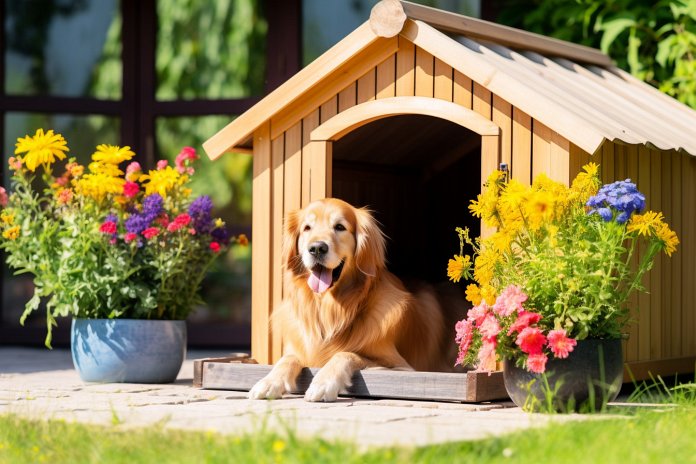
Ensuring the well-being of your dog is not only important to you as an owner, but it is also a legal responsibility. Each state has set regulations that must be adhered to. One contentious issue is whether dogs should solely live in outdoor kennels. Some argue that this is not an ideal way to keep dogs, while others believe it is acceptable as long as the dog has a safe and warm sleeping area, access to food and water, and protection from the elements. This article examines whether dogs can actually live comfortably in outdoor kennels.
Signs of a Happy Dog in an Outdoor Kennel
To determine if your dog is content in their outdoor kennel, consider the following signs: a wagging tail, jumping up and engaging in play, tilting of the head playfully, and a relaxed ear pose. On the other hand, signs of a stressed dog include excessive barking, whining, growling, and destructive behavior. It is important to take into account your dog’s breed and temperament when deciding if an outdoor kennel is suitable.
Body Language
Additional signs that indicate a dog is not enjoying their outdoor kennel include growling, head tilting, whining, chewing, jumping up, and wagging tail. Other signs to watch for are destructive behavior, withdrawal, and fearful tendencies.
Historical Perspective
Throughout history, opinions on dogs living indoors or outdoors have varied. However, the bond between humans and dogs has always been strong. Dogs were considered family members even thousands of years ago. Dogs thrive in this relationship and are well cared for. Historically, dogs often served a purpose and would be outside or inside depending on the circumstances. However, they had more freedom and fewer dangers compared to today’s world.
Scientific Considerations
From a scientific standpoint, as long as a dog thrives physically and mentally, they can live in an outdoor kennel. Factors such as breed, climate, treatment, age, and health play a role in determining if a dog will thrive. Certain breeds are better suited for outdoor living, while others require more shelter and specific conditions. Providing adequate provisions such as heating or air conditioning can make outdoor kennels suitable for dogs.
Training Dogs for Outdoor Living
If you choose to keep your dog in an outdoor kennel and they are well-adapted to the environment, there are certain steps to follow. Give your dog time to adapt to the kennel and create a positive association with it through treats, toys, blankets, and a comfortable sleeping area. Ensure your dog receives proper care, including regular walks and interaction with you and other animals.
Conclusion
Ultimately, the decision to keep a dog in an outdoor kennel depends on various factors, including the individual dog’s breed, temperament, and environmental conditions. It is essential to prioritize your dog’s well-being and provide a safe and comfortable living space, regardless of whether they reside indoors or outdoors.
“A dog’s well-being extends beyond the walls of their kennel.”

Tips & Things to Know
1️⃣ Consider your dog’s breed and temperament: Not all dogs are suited for living in outdoor kennels. Take into account your dog’s breed and temperament to determine if they will be happy and content in an outdoor environment.
2️⃣ Look for signs of happiness or stress: Pay attention to your dog’s body language to determine if they are enjoying their outdoor kennel. Signs of happiness include tail wagging, jumping up, head tilting, and a neutral ear pose. Signs of stress include barking, whining, growling, and chewing.
3️⃣ Provide proper care and attention: Even if your dog is living in an outdoor kennel, they still need proper care and attention. Take the time to adapt your dog to their new environment, provide toys, blankets, and treats to make the kennel a safe and comfortable space, and continue to engage in walks and interaction with your dog.
Frequently Asked Questions, Answered ✅
1. What are the signs that indicate a dog is happy living in an outdoor kennel?
– Tail wagging, jumping up, head tilting, and a neutral ear pose are signs that indicate a happy dog in an outdoor kennel.
2. What are the signs that indicate a dog is stressed out about living in an outdoor kennel?
– Barking, whining, growling, and chewing on items in the kennel are signs that indicate a stressed dog in an outdoor kennel.
3. How does a dog’s breed affect their ability to live in an outdoor kennel?
– Different dog breeds have different tolerances for outdoor environments, so it’s important to consider their breed when deciding if an outdoor kennel is suitable for them.
4. What are some other signs that indicate a dog is not enjoying their outdoor kennel?
– Destructive behavior, becoming withdrawn, and displaying fearful tendencies are signs that indicate a dog is not enjoying their outdoor kennel.
5. What factors should be considered when deciding if an outdoor kennel is suitable for a dog?
– Factors such as the dog’s breed, climate, time of year, age, health, and how they are treated should be considered when deciding if an outdoor kennel is suitable for a dog.